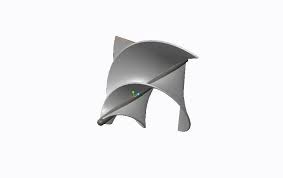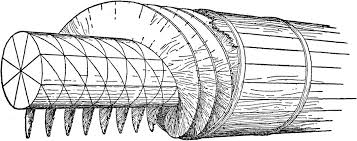Andrew Defanto
Resume About Design and Analysis of Archimedes Aero-Foil Wind Turbine Blade For Light and Moderate Wind Speed
Wind is an abundant resource and its utilization cannot be affected by climate and weather. Futhermore, it is a resource of the renewable power. The device (wind turbine) are act as the converter from wind kinetic energy into power which can provide electricity for the home, etc. and also large scales. The device itself consist of several parts such as the rotor, generator, control system, and so on. The rotor itself driven by the wind and predefined speeds in term of the wind speed. The orientation of the shaft and rotational axis which are mounted to the turbine define the type of the turbine.
In early ages, shape of the aeroplane wings were used for the model of the turbine blades. Selection of aerofil shape is the most crucial as it is the important variable to deteremine the maximum conversion of the kinetic energy into rotational energy. The journal focused on the Archimedes wind turbine new design. Futhermore, the design are consisting of three circular blade, wrapped around one another which act as coils and then expanded creating a three-dimensional conical turbine. Thus, this design both use the lift and drag force and also guaranteed that wind is drawn into the turbine with an effective angle of 90 degrees by the coils.
The image below shows a diagram of Archimedes wind turbine having three blades connected to each other at 120 degrees and symmetric arrangement to the shaft
The outer diameter of the Archimedes Spiral wind turbine is 1500 mm, the thickness is 5mm and the length is 1500mm. The design fuction are using the selction of aerofil and the shape aerodynamics are selected for the blade performance. The choice is based on the compairing lift and drag over different aerofils. The dimensions are scaled from the NACA 6409 aerofil shape and scaled to AAWT dimension by using MATLAB. The final design is rather complex.
The analysis of the result is using some methodology such as computational method, mesh generation and boundry setup. From the analysis, we can conclude that using aerofil to and Archimedes wind turbine can increase the torque at a lower speed nearly 15% that AWT, it also shows that the Archimedes wind turbine can extract more power in low and moderate- wind speed than other wind turbine. Futhermore, the design requires less cost which is caused by none of electronic yawning needed because the usage of drag and lift force and also the Archimedes aerofil wind turbine mlooks getting more promising power thand other wind turbine.
Design and Preference On Creating Archimedes Hydropowered Turbine
Abstract
Archimedes screw are one of the oldest machines being use, a device which used to lifting water for irrigation and drainage purposed. The device however, very helpful for people in that era to take water form downhill and transfer it to uphill in ease. Futhermore, the instrument keep being used in Roman civilitation as Vitruvius gave the detail of Archimedes Screw itself on his book De Architectura on the first century B.C. The design itself begins with a tree trunk shaped into a cyclindrical core whose length is 16 times its diameter.
In nowdays, the design of Archimedes pump is taken for other purposes, such as turbine. Futhermore, the Vitruvius screw design are developed as turbine blades. The advantages of this design are, no need draft-tube, fish-friendly, and can be operated in low head (H<10m). Moreover, the screw turbine is classified as reaction turbine and produce electricity via a transmission. The specific weight of the water causes the screw to rotate, thus it results the maximum efficiency of 100% (Muëller Gerald 2009). The optimum ratio of pitch depends on the number of blades and the radius ratio (R₁/R₀) is equal to 0.54. In addition, the efficiency of the screw turbine is influenced by geometric shape and its flow losses.


